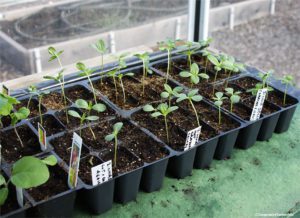March 12 column: Seed-starting

My column in today’s edition of The Spokesman-Review is all about seed-starting. That’s one of my favorite aspects of gardening. Here’s a link to it: Seed-starting basics. (or you can read my column lower in this text)
For the past 3 weeks, I’ve been laying the foundation for growing a garden. There are many important things to know. These include choosing a good site, knowing your hardiness zone and how to select plants and seeds. But today, I finally get to cover the hands-on information you need to know for starting your garden. And that’s very exciting!
Being able to start your own plants from seed is one of the best gardening skills you can learn. For one thing, it’s very economical once you purchase a few basic pieces of equipment. For another, it gives you the ability to grow hard-to-find plant varieties.
I’ve also shot a video to go along with today’s column. I’ll show you 3 of my favorite seed-starting systems. There’s also a quick slideshow that goes through the seed-starting steps, just to reinforce them in your mind. Have a look:
Seed-Starting Basics garden column:
by Susan Mulvihill
Growing your own plants from seed is one of the best gardening skills you can learn. Whether planting vegetable or flower seeds, the concepts are the same.
For supplies, you’ll need planting containers, a clear plastic cover or bag for the container, seed-starting mix or potting soil, plant markers, a bright location and, of course, seeds.
Seed packets are a wealth of information. They’ll tell you whether to plant them indoors or directly into the garden. In addition to annual flowers, I typically start artichokes, beans, celery, corn, cucumbers, eggplants, melons, peas, peppers, tomatoes and squash indoors.
The packets list the number of weeks before the last frost date to plant them inside. In the Inland Northwest, our last frost is usually around mid-May so grab a calendar and count backwards for your starting dates. If you’d like a little help in that regard, there’s a planting schedule showing when I start my seeds on SusansintheGarden.com under the “Guides” menu.
Seed packet information also includes the seed-planting depth, spacing, how long it will take the seeds to germinate (sprout) and how much to space them when transplanting them into the garden.
Let’s go through the seed-starting process:
Just about any type of container will work, as long as there are drainage holes. Garden centers carry plastic flats and inserts with varying sizes of planting cells in them. Some folks recycle clear plastic produce containers from the grocery store, take-out boxes, milk jugs cut in half or egg cartons.
For a planting medium, you can use potting mix or seed-starting mix, which is usually a combination of peat moss and perlite, vermiculite or coconut coir. Avoid using garden soil which compacts easily, can contain pathogens and might be difficult to keep moist.
Start by filling a bucket with your planting medium and moistening it until it contains the amount of moisture you’d feel in a wrung-out sponge. You don’t want it dripping wet.
Fill your planting container with about 2 to 3 inches of it and press down lightly to create a nice planting bed. Plant the seeds at the recommended depth and cover them with additional planting mix as needed.
Here’s an extra step I take to inhibit the deadly fungus that causes damping-off disease: I lightly sprinkle some milled sphagnum moss over the top of the planting container. You can find it at large garden centers like Northwest Seed & Pet or online.
Place a clear plastic lid over the container or wrap a plastic bag around it. This increases humidity which in turn causes the seeds to germinate. Put your container in a well-lit area, either under grow lights or in a sunny window.
Once the majority of the seeds have sprouted, remove the lid. From this point on, you’ll need to monitor the soil moisture so it stays lightly moist.
As soon as the seedlings have one or two pairs of true leaves — the regular leaves of a plant instead of the simple seed leaves it started out with — you can give them a little something to eat. I like to use a half-strength dilution of fish fertilizer and water for this. When the seedlings become more established, especially when you start seeing a root or two emerging from the bottom of the container, transplant them into a larger pot where they can stay until it’s safe to move them out to the garden.

